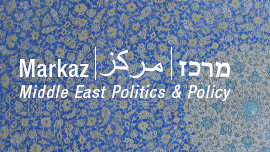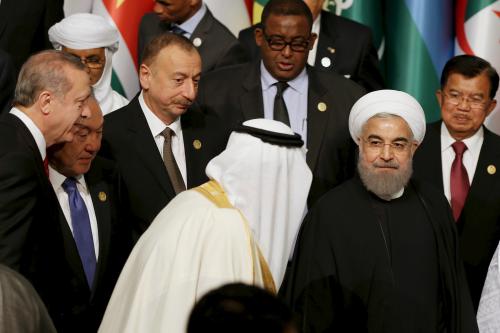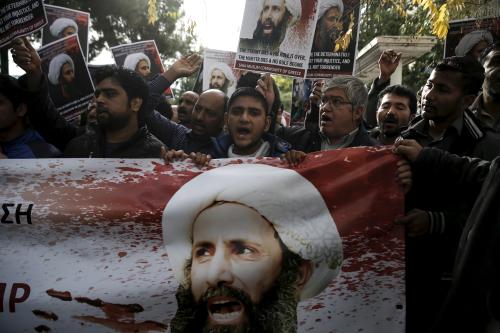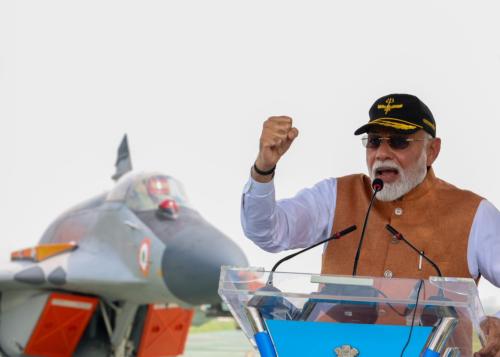Content from the Brookings Doha Center is now archived. In September 2021, after 14 years of impactful partnership, Brookings and the Brookings Doha Center announced that they were ending their affiliation. The Brookings Doha Center is now the Middle East Council on Global Affairs, a separate public policy institution based in Qatar.
While Saudi-Iranian tensions have been on the rise for years, Saudi Arabia’s execution of Sheikh Nimr al-Nimr in January—met with angry reactions in Iran—heightened the stakes so dramatically that there is now serious potential for direct confrontation. Emotions are running high, and even an accidental spark could turn the cold war between the two regional powers hot. Their antagonism is a grave threat to the wider region, which isn’t exactly a bastion of stability these days—and it’s contrary to the long-term interests of Saudi Arabia and Iran.
Muhammad bin Salman, Saudi Arabia’s Deputy Crown Prince and Minister of Defense, stressed in a January interview with The Economist that “a war between Saudi Arabia and Iran [would be] the beginning of a major catastrophe in the region,” adding: “For sure we will not allow any such thing.”
The prince is right—an outright Saudi-Iranian conflict would quickly spiral into a region-wide conflagration with gravely destabilizing effects on the Middle East and beyond. Yet the provocative rhetoric and actions of leaders on both sides continue to fan the flames.
Both sides must work to reduce the temperature and address the root causes of the tension. There are three main considerations that should inform the approach:
- First, each misunderstands the other. While Iranian-Emirati and Iranian-Omani relations are based on dialogue and exchange, Iranian-Saudi relations are based on misunderstanding, ignorance, and isolation. Combined with heightened sectarian prejudice, which has emerged largely in the fertile landscape for hatred and division sown by the 2003 U.S. invasion of Iraq, the long-running enmity between the two nations has only worsened.
- Second, due to Iran being isolated and sanctioned ever since its 1979 revolution, a network of militia leaders, mujahedeen, intelligence agencies, and high-ranking clerics have been able to hijack the state. Rather than pursue national interests such as improving regional cooperation or increasing inward investment, Iranian foreign policy has largely served the private interests of that network. These actors have the most to lose as Iran becomes more open, as their space to maneuver in the shadows would be reduced. In Saudi Arabia and elsewhere in the Arab world, observers tend to perceive Iran’s actions in the region as targeting Saudi Arabia. But often, Iran’s intent is to enrich that shadowy network. The Saudis and Arabs more broadly should support the lifting of sanctions, since it will squeeze those actors in Iran—yet what we see is the opposite. Saudi Arabia could help empower those who genuinely want reform in Iran by encouraging more openness.
- Third, Iran-Saudi tensions are kept alive by the ever-narrowing space between religious institutions and policymakers in Saudi Arabia. The problem for the House of Saud is that its legitimacy is derived from its custodianship of Mecca and Medina—it needs to appease the clerics, who have unfortunately slid into divisive sectarian rhetoric. The late King Abdullah made steps to distance the state from the clergy, but King Salman’s monarchical arrangement is different, resulting in a shift back toward the clerics.
From vicious to virtuous cycle
To head off outright confrontation, Saudi Arabia and Iran need to identify potential areas of shared interest. Both states’ economies are dependent on oil, and both are working to reduce that reliance. To some extent, each country’s economy depends on the other’s success. Both are targeted by the same terror groups, including al-Qaida and the Islamic State. And the countries face similar environmental threats, including oil spills, challenges related to accelerated industrialization, and water shortages. In all of these areas, Iran and Saudi Arabia can work together.
It won’t be easy, but there are helpful historical examples. Seventy years ago, no one could have imagined France, Germany, and Britain overcoming their regional rivalries to become close political and economic partners. And there are constructive roles for outside powers: Europe, for example, could facilitate more dialogue on religious tolerance in the Middle East, focusing on the 2004 Amman Message that all Muslims have common interests and can unite. Europe can also be more vigilant in ensuring that divisive sectarian clerics do not abuse their political asylum by using it as a platform to broadcast incendiary misinformation and propaganda that often crosses the line into hate speech. Meanwhile, multi-track diplomacy and various types of cultural, educational, and social exchanges between Saudis, Iranians, and others can help break down the barriers of misunderstanding and prejudice.
War between Iran and Saudi Arabia is not inevitable, but both sides must take steps now to turn down the heat. At the end of the day, it is in neither state’s interest to let their already poor relations spiral further downward.
The Brookings Institution is committed to quality, independence, and impact.
We are supported by a diverse array of funders. In line with our values and policies, each Brookings publication represents the sole views of its author(s).







Commentary
Is the Iranian-Saudi “cold war” heating up? How to reduce the temperature
June 22, 2016